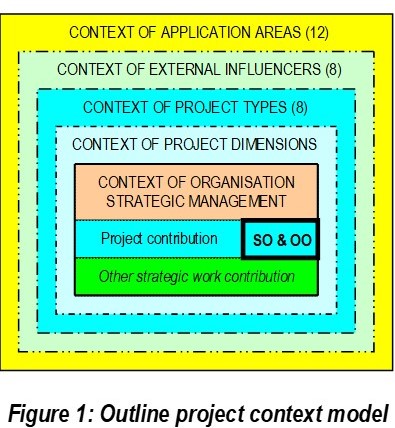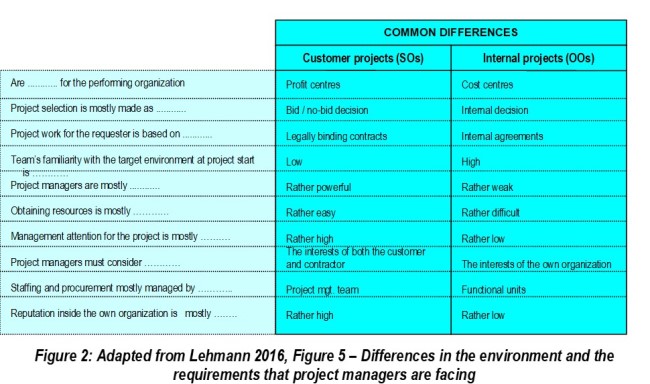by supplier organisations (SOs) and by owner organisations (OOs)
Series on Project Contexts
SERIES ARTICLE
By Alan Stretton, PhD (Hon)
Sydney, Australia
INTRODUCTION
 This is the third of a series of seven articles which identify and discuss a variety of key contexts which impact on the management of projects. The basic reason for developing this series is that there is far too little attention given to the contexts of projects in the relevant literature – particularly when you consider that, in practice, effective management of projects’ contexts is usually quite critical to achieving overall project management (PM) success.
This is the third of a series of seven articles which identify and discuss a variety of key contexts which impact on the management of projects. The basic reason for developing this series is that there is far too little attention given to the contexts of projects in the relevant literature – particularly when you consider that, in practice, effective management of projects’ contexts is usually quite critical to achieving overall project management (PM) success.
The first article of this series (Stretton 2019e) identified six key types of project contexts. These were summarised pictorially into a combined model, depicted in skeleton format in Figure 1 to the left.
The second article of this series (Stretton 2019f) was concerned with further discussion of the context of organisational strategic management. This third article is concerned with supplier organisations (SOs) and owner organisations (OOs) as indicated by heavier outlines in Figure 1. It will focus on two groups of extended SO services, and with OOs that create and manage long-term assets.
RECAPPING REPRESENTATIONS OF PROJECTS IN THE CONTEXTS OF BEING UNDERTAKEN BY SOs AND OOs IN THE FIRST ARTICLE
Some definitions/descriptors of the two types of organisations – SOs and OOs
There are two quite different groups of organizations that plan and execute projects. Taggart 2015 describes them as Supplier Organizations (SOs) and Owner Organizations (OOs). For many years I followed Cooke-Davies 2002 in describing these as project-based and production-based organizations respectively. I borrowed from Archibald et al 2012 (who use different descriptors) in defining them as follows:
- Project-based organizations [SOs] derive most (if not all) of their revenue and/or other benefits from creating and delivering projects.
- Production-based organizations [OOs] derive most (if not all) of their revenue and/or benefits from producing and selling products and services. They utilize projects to create or improve new products and services, enter new markets, or otherwise improve or change their organizations.
Lehmann’s list of differences for project management between SOs and OOs
Lehmann 2016 uses the descriptor “customer projects” to describe projects delivered by an SO to an OO, and “internal projects” to describe projects run internally by an OO. I adapted his table of differences as shown below in Figure 2 (originally in Stretton 2017e).

Other differences for project management between SOs and OOs
I added the following observations about such differences:
- In the SO context the project manager often has to cover a wider range of project life-cycle processes than in the OO context.
- The extent of the project manager’s responsibility and authority in the SO context is generally far greater than in OOs.
- In the SO context, our perspective in Civil & Civic (C&C) was that if you were managing a project, you were managing a business, and that that was the project manager’s job, albeit with appropriate support.
- The project management literature tends to focus on internal OO projects. However, Taggart 2015 suggests that there appear to be more project people working in SOs than OOs, and that bodies of knowledge should give more guidelines that are particular to project management in SOs.
More…
To read entire article, click here
How to cite this paper: Stretton, A. (2019). 3. Contexts of projects undertaken by supplier organisations (SOs) and by owner organisations, Series on Project Contexts, series article 3. PM World Journal, Volume VIII, Issue VII, August. Available online at https://pmworldlibrary.net/wp-content/uploads/2019/08/pmwj84-Aug2019-Stretton-projects-by-supplier-and-owner-organisations-PM-context-series-3.pdf
About the Author

Alan Stretton, PhD
Faculty Corps, University of Management
and Technology, Arlington, VA (USA)
Life Fellow, AIPM (Australia)
![]()
Alan Stretton is one of the pioneers of modern project management. He is currently a member of the Faculty Corps for the University of Management & Technology (UMT), USA. In 2006 he retired from a position as Adjunct Professor of Project Management in the Faculty of Design, Architecture and Building at the University of Technology, Sydney (UTS), Australia, which he joined in 1988 to develop and deliver a Master of Project Management program. Prior to joining UTS, Mr. Stretton worked in the building and construction industries in Australia, New Zealand and the USA for some 38 years, which included the project management of construction, R&D, introduction of information and control systems, internal management education programs and organizational change projects. He has degrees in Civil Engineering (BE, Tasmania) and Mathematics (MA, Oxford), and an honorary PhD in strategy, programme and project management (ESC, Lille, France). Alan was Chairman of the Standards (PMBOK) Committee of the Project Management Institute (PMI®) from late 1989 to early 1992. He held a similar position with the Australian Institute of Project Management (AIPM), and was elected a Life Fellow of AIPM in 1996. He was a member of the Core Working Group in the development of the Australian National Competency Standards for Project Management. He has published over 200 professional articles and papers. Alan can be contacted at alanailene@bigpond.com.au.
To see more works by Alan Stretton, visit his author showcase in the PM World Library at http://pmworldlibrary.net/authors/alan-stretton/.









